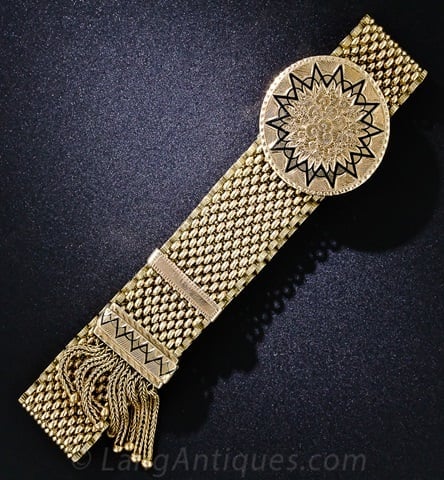A Guide to Mid-Victorian Grand Period Jewelry
The Mid-Victorian Period saw many changes in society and fashion. Learn what distinguishes Grand Period jewelry, particularly its opulent style and weight.
3 Minute Read
What was the Grand Period?
In 1879, the incandescent bulb placed jewelry in a whole different light, literally. Diamonds dazzled under electricity. The discovery of a diamond mine in South Africa in 1867 had created a great demand for the gems. The Grand Period also opened doors socially for women. As men were called to war, women filled the jobs they vacated.
Queen Victoria mourned her husband until her death in 1901. This set the tone for Grand Period jewelry manufacturing. However, her subjects buckled under the heavy gloom. By 1885, they eventually turned to the lighter jewelry and clothing styles of the Late Victorian Aesthetic Period.
Notable Characteristics of Grand Period Jewelry
Heavy, massive jewelry reflected the opulence of the time, as industry boomed and created millionaires overnight.
Jewelry makers used silver enthusiastically after its discovery in Nevada in 1860.
Grand Period jewelry often featured gemstones in hammer or so-called "gypsy" style settings. The gems were almost embedded into the pieces, with minute prongs holding them in place. Pavé settings, also popular, featured stones set with almost invisible prongs, creating pieces "paved" with gems.
Brooches now contained a lever catch in the "C" design clasp for improved security.
Metal Work
Jewelry metals commonly used during this period included the following:
- Low karat gold (9k, 12k, and 15k)
- Rolled gold
- Silver
- Steel
Motifs
Popular motifs included included the following:
- Acorns
- Bees
- Bells
- Birds
- Crescents
- Crosses
- Daisies
- Hearts
- Monograms
- Stars
- Shield shapes
Geometric patterns were common. Enameling remained popular.
Archeological digs continued during this period, generating great public curiosity. Thus, Ancient Greek, Roman, and Egyptian designs remained popular and inspired cameo use. Excavations of Ancient Etruscan cities in Italy brought about a revival of Etruscan designs in jewelry. In particular, an ancient metal technique featuring fine, beaded granulation was resurrected.
Popular Gemstones and Cutting Styles in Grand Period Jewelry
Popular stones included:
"Carbuncles," or cabochon-cut garnets, commonly appeared in pendants, brooches, and necklaces.
Materials such as bog oak, coral, ivory, and tortoiseshell were also used as gems.
Goldstone, a glass gem simulant, was widely used.
Notable gem cutting styles included the following:
- Rose Cut: round shape with a domed top and flat bottom.
- Old Mine Cut: rounded square shape with many facets. Closely resembles today's modern round brilliant cut.
- Cabochon: rounded top and flat bottom.
What Were the Hot Items in Grand Period Jewelry?
Earring of all sizes were popular. Post earrings were introduced during this time period.
Other popular items included the following:
- Hair jewelry
- Large necklaces with large pendants
- Long, rectangular bar pins
- Tiaras and tortoiseshell combs
Cabochons with Embedded Gems
Jewelers would sometimes embed smaller gem designs in the center of cabochons.
For example, this locket features a 0.25-ct cabochon-cut amethyst with an embedded starburst of eighteen rose-cut diamonds surrounding a centered, Old Mine-cut diamond, 0.37-ct total weight. The blue beads reflect the Etruscan revival. This piece boasts a substantial amount of gems and exquisite craftsmanship. The combination makes this locket a rare find.
Memorial Jewelry
This locket features two round and clear rock quartz discs hinged at the top in 15k yellow gold. With the name of a loved one and the date of death engraved on the front, this piece exemplifies the memorial jewelry popular during this period. The locket's excellent condition and engraving make it valuable.
Micro-Mosaic Jewelry
Fabricated in Florence, Rome, and Venice, these pieces assembled tiny tiles of gemstones and glass (tesserae) into artistic designs.
For example, this micro-mosaic brooch features an Egyptian scarab beetle fashioned entirely out of tiny glass tiles. A 15k yellow gold mounting houses the micro-mosaic. How closely the tiles fit together and whether they're free from chips or cracks set the value of micro-mosaics.
Bracelets
Popular styles included the following: bracelets with buckles; wide mesh bracelets with enameling and foxtails; and wide bangle bracelets.
For example, the wide bangle bracelet below serves as an excellent example of Grand Period jewelry style. Silver with gold overlay, the bangle features acorns and leaves as motifs. This substantial piece is in excellent condition.
Lockets
This locket features carbuncles surrounding a star of nine Old Mine-cut diamonds. These gems are set in a 15k yellow gold mounting with scalloped edges. The locket also has a hinged, garnet drop. The perfectly matched and cut garnets, along with the number of diamonds, make this piece valuable.
Megan Coward, Graduate Jeweler Gemologist, GIA, Graduate Gemologist
Megan Coward is a graduate of the GIA with Graduate Jeweler Gemologist and Graduate Gemologist accreditations. She has 20+ years in the retail jewelry industry in various roles including as a diamond buyer and gemstone appraiser.
Related Articles
The Regent Diamond: Jewel of Empires and Revolutions
Lapidary Technology Through the Ages: Laps and Polish
La Pelegrina Pearl: No Ordinary Royal Treasure
Vintage Engagement Rings: Guide to Four Eras
Latest Articles
Identifying Synthetic Gems
Ten Big, Beautiful, and Affordable Engagement Ring Stones
Rhodochrosite Value, Price, and Jewelry Information
Ruby and Sapphire Survey: Where Do You Draw the Line?
Never Stop Learning
When you join the IGS community, you get trusted diamond & gemstone information when you need it.
Get Gemology Insights
Get started with the International Gem Society’s free guide to gemstone identification. Join our weekly newsletter & get a free copy of the Gem ID Checklist!
